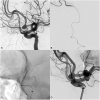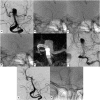Single-Center Experience With the Bare p48MW Low-Profile Flow Diverter and Its Hydrophilically Covered Version for Treatment of Bifurcation Aneurysms in Distal Segments of the Anterior and Posterior Circulation
- PMID: 33071937
- PMCID: PMC7538783
- DOI: 10.3389/fneur.2020.01050
Single-Center Experience With the Bare p48MW Low-Profile Flow Diverter and Its Hydrophilically Covered Version for Treatment of Bifurcation Aneurysms in Distal Segments of the Anterior and Posterior Circulation
Abstract
Background and Purpose: Flow diversion has profoundly changed the way aneurysms are treated. However, it conventionally requires dual antiplatelet medication and has yet been considered off-label use in the posterior circulation or within peripheral vessels of the anterior circulation. Here, we report our experience with the p48MW/p48MW hydrophilic coating (HPC) in the anterior and posterior circulation. This novel low-profile flow diverter is specifically designed for treatment of small peripheral vessels, and the p48MW HPC has an anti-thrombotic polymer coating, which allows application of a single antiplatelet function medication in conditions that expectably require further surgery. Materials and Methods: Thirty-two patients were prospectively included. Twenty-six treatments were performed with one flow diverter, four required two overlapping flow diverters, one case demanded three overlapping flow diverters, and in one case, extensive dissecting aneurysm telescoping with eight flow diverters was necessary. Twenty-two complex bifurcation aneurysms were treated. Three months' follow-up was available for 14 patients. Results: Deployment was uneventful in all cases. In four cases, undersizing was unavoidable and resulted in significant shortening of the flow diverter, which demanded implantation of further flow diverters to sufficiently treat the target aneurysm. Three flow diverters required balloon angioplasty for optimal wall approximation. All parent vessels remained patent. Available 3-month follow-up studies showed decreased influx or delayed washout in all aneurysms; none was occluded completely. There were no device-related clinical complications. Conclusions: Implantation of the p48MW/p48MW HPC is safe and effective for treatment of distally located cerebral aneurysms. Considering the reported rates of ischemic complications associated with flow diversion of complex bifurcation aneurysms, the p48MW/p48MW HPC potentially provides increased safety for complex bifurcation aneurysms in the anterior and posterior circulation.
Keywords: cerebral aneurysm; flow diversion; p48MW; reduced platelet function inhibition; small cerebral vessels.
Copyright © 2020 Schob, Kläver, Richter, Scherlach, Maybaum, Mucha, Schüngel, Hoffmann and Quaeschling.
Figures



Similar articles
-
Early clinical experience with the p48MW HPC and p64MW HPC flow diverters in the anterior circulation aneurysm using single anti-platelet treatment.Interv Neuroradiol. 2022 Jun;28(3):266-276. doi: 10.1177/15910199211029503. Epub 2021 Jul 7. Interv Neuroradiol. 2022. PMID: 34233547 Free PMC article.
-
Distal Flow Diversion with Anti-Thrombotically Coated and Bare Metal Low-Profile Flow Diverters-A Comparison.J Clin Med. 2023 Apr 4;12(7):2700. doi: 10.3390/jcm12072700. J Clin Med. 2023. PMID: 37048781 Free PMC article.
-
The p48 Flow Modulation Device with Hydrophilic Polymer Coating (HPC) for the Treatment of Acutely Ruptured Aneurysms: Early Clinical Experience Using Single Antiplatelet Therapy.Cardiovasc Intervent Radiol. 2020 May;43(5):740-748. doi: 10.1007/s00270-020-02418-4. Epub 2020 Feb 6. Cardiovasc Intervent Radiol. 2020. PMID: 32030488 Free PMC article.
-
Posterior circulation flow diversion: a single-center experience and literature review.J Neurointerv Surg. 2015 Aug;7(8):574-83. doi: 10.1136/neurintsurg-2014-011281. Epub 2014 Jul 1. J Neurointerv Surg. 2015. PMID: 24984708 Review.
-
Treatment of complex anterior cerebral artery aneurysms with Pipeline flow diversion: mid-term results.J Neurointerv Surg. 2017 Feb;9(2):147-151. doi: 10.1136/neurintsurg-2016-012519. Epub 2016 Jul 5. J Neurointerv Surg. 2017. PMID: 27382125 Review.
Cited by
-
Endovascular treatment of challenging aneurysms with FRED Jr flow diverter stents: a single-center experience.Jpn J Radiol. 2023 Mar;41(3):322-334. doi: 10.1007/s11604-022-01354-2. Epub 2022 Oct 31. Jpn J Radiol. 2023. PMID: 36315360 Free PMC article.
-
Endovascular treatment of intracranial vertebral artery unruptured dissecting aneurysms: Comparison of flow diversion and stent-assisted coiling or stenting alone.Front Neurol. 2022 Aug 23;13:919866. doi: 10.3389/fneur.2022.919866. eCollection 2022. Front Neurol. 2022. PMID: 36081876 Free PMC article.
-
Initial Experience with the New DERIVO® Mini Embolisation Device for the Treatment of Intracranial Aneurysms.Brain Sci. 2024 Sep 10;14(9):911. doi: 10.3390/brainsci14090911. Brain Sci. 2024. PMID: 39335406 Free PMC article.
-
First Experience of Three Neurovascular Centers With the p64MW-HPC, a Low-Profile Flow Diverter Designed for Proximal Cerebral Vessels With Antithrombotic Coating.Front Neurol. 2021 Sep 14;12:724705. doi: 10.3389/fneur.2021.724705. eCollection 2021. Front Neurol. 2021. PMID: 34594297 Free PMC article.
-
Early clinical experience with the p48MW HPC and p64MW HPC flow diverters in the anterior circulation aneurysm using single anti-platelet treatment.Interv Neuroradiol. 2022 Jun;28(3):266-276. doi: 10.1177/15910199211029503. Epub 2021 Jul 7. Interv Neuroradiol. 2022. PMID: 34233547 Free PMC article.
References
-
- Colby GP, Bender MT, Lin LM, Beaty N, Caplan JM, Jiang B, et al. . Declining complication rates with flow diversion of anterior circulation aneurysms after introduction of the Pipeline Flex: analysis of a single-institution series of 568 cases. J Neurosurg. (2018) 129:1475–81. 10.3171/2017.7.JNS171289 - DOI - PubMed
LinkOut - more resources
Full Text Sources

